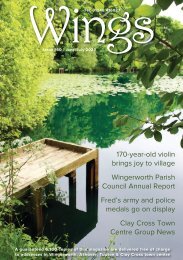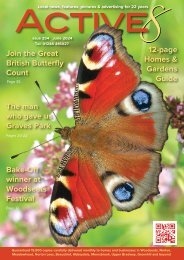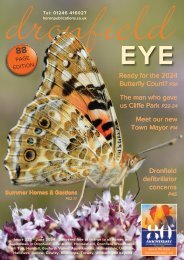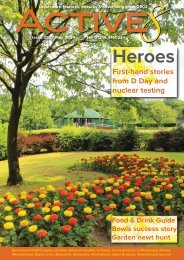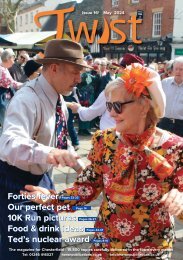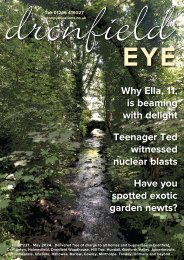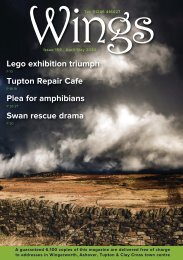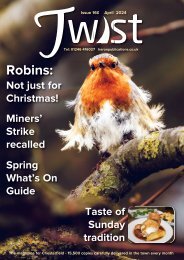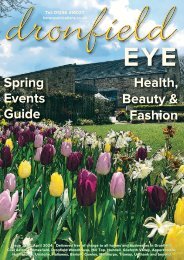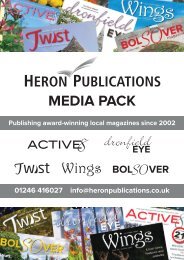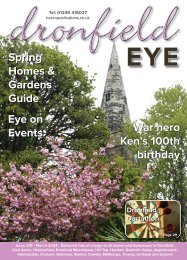Dronfield Eye issue 203 November 2022
You also want an ePaper? Increase the reach of your titles
YUMPU automatically turns print PDFs into web optimized ePapers that Google loves.
dronfield EYE<br />
Blackberries<br />
Blackthorn<br />
Elderberries<br />
Autumn’s rich berry harvest<br />
Animals and birds are gorging<br />
themselves on berries right<br />
now, fattening themselves up<br />
in preparation for winter.<br />
Prof Ian Rotherham explains<br />
W<br />
ITH our long, hot summer and<br />
plenty of sunshine, this year has<br />
undoubtedly been great for fruit and<br />
berries. This is especially those<br />
growing wild in hedgerows, along<br />
woodland edges, and what we used to<br />
call ‘waste ground’.<br />
Common shrubs like brambles or<br />
blackberries have been almost weighed<br />
down with especially heavy fruit hanging on<br />
every branch; a rich harvest for birds like<br />
blackbirds and mammals such as wood mice.<br />
By late summer, many animals and birds<br />
are fattening up for the hardship of winter to<br />
come. Rich pickings of fruit, berries, and nuts<br />
in the countryside and gardens are<br />
absolutely vital.<br />
A number of readers have asked about the<br />
lack of garden birds coming to feeders in<br />
August through to October, but don’t worry,<br />
this is entirely normal. During late summer<br />
and into autumn things are in flux and having<br />
bred, many garden birds gather in small<br />
flocks to roam and forage in the local<br />
countryside.<br />
As nights get colder and the abundant<br />
autumnal harvest has been consumed, at<br />
least in part, the birds will return.<br />
Some species have departed south for the<br />
winter and warmer climates, soon to be<br />
replaced by winter visiting migrants from the<br />
north. The Arctic thrushes (redwings and<br />
fieldfares) will soon be arriving, and finches<br />
such as bramblings, redpolls, and siskins will<br />
also be ranging across woods, park, hedges<br />
and gardens.<br />
The thrushes, including mistle thrush, song<br />
thrush, and blackbirds, love the red berries<br />
of hawthorn and rowan whereas the finches<br />
36<br />
Hawthorn<br />
Rowan<br />
and buntings feed on seeds of trees like<br />
alder, birch and larch.<br />
In the wildlife garden, planning ahead and<br />
planting berry-bearing trees and shrubs<br />
brings dividends of abundant free birdfood<br />
to benefit the birds - and your pocket. What’s<br />
more, some of these plants (honeysuckle for<br />
instance) can be grown freely from cuttings<br />
to provide fragrant blossoms throughout the<br />
summer and then lots of autumn berries.<br />
Other trees and shrubs are easily<br />
propagated from berries, grown on, and then<br />
planted out. St John’s worts (Hypericums) for<br />
instance, can be pulled apart to provide root<br />
cuttings that spread freely, and guelder rose<br />
is another easy-to-grow shrub with gorgeous<br />
berries.<br />
For shorter-term results and quick birdfood,<br />
then herbaceous plants like teasel are<br />
great, and many flowering perennials like<br />
garden knapweed are favourites with<br />
goldfinches, greenfinches and titmice.<br />
But don’t forget wild herbs that produce<br />
winter berries, and these include the bright<br />
red fruits of our wild arum lily, the cuckoo<br />
flower or lords and ladies. This is easily<br />
grown in gardens along with the more<br />
spectacular Italian arum lily and has herbal<br />
medical associations and rich folklore too.<br />
With poisonous berries (at least to humans),<br />
the plant is best left alone although the<br />
toxins were once extracted and used to treat<br />
a range of ailments.<br />
The highly acrid berries are an irritant and<br />
moreover cause swelling, burning, and<br />
difficulty in breathing. Yet animals and birds<br />
take them freely as a good source of food<br />
and with no obvious signs of harm. The<br />
berries are eaten and seeds dispersed along<br />
hedgerows and woodland edge.<br />
• Prof Ian D. Rotherham, researcher, writer,<br />
broadcaster on wildlife and environmental<br />
<strong>issue</strong>s is contactable on<br />
info@hallamec.plus.com ; follow his website<br />
and blog: www.ukeconet.org<br />
& ianswalkonthewildside.wordpress.com/<br />
& Twitter @IanThewildside






